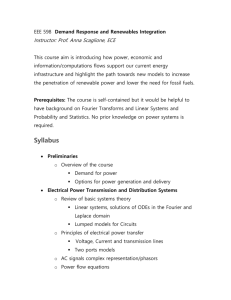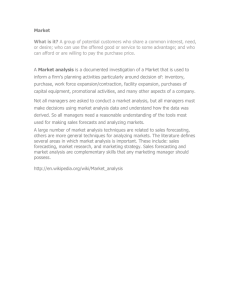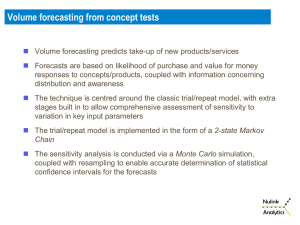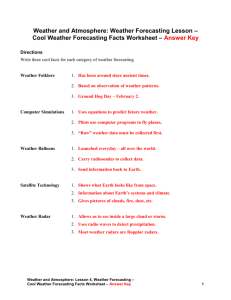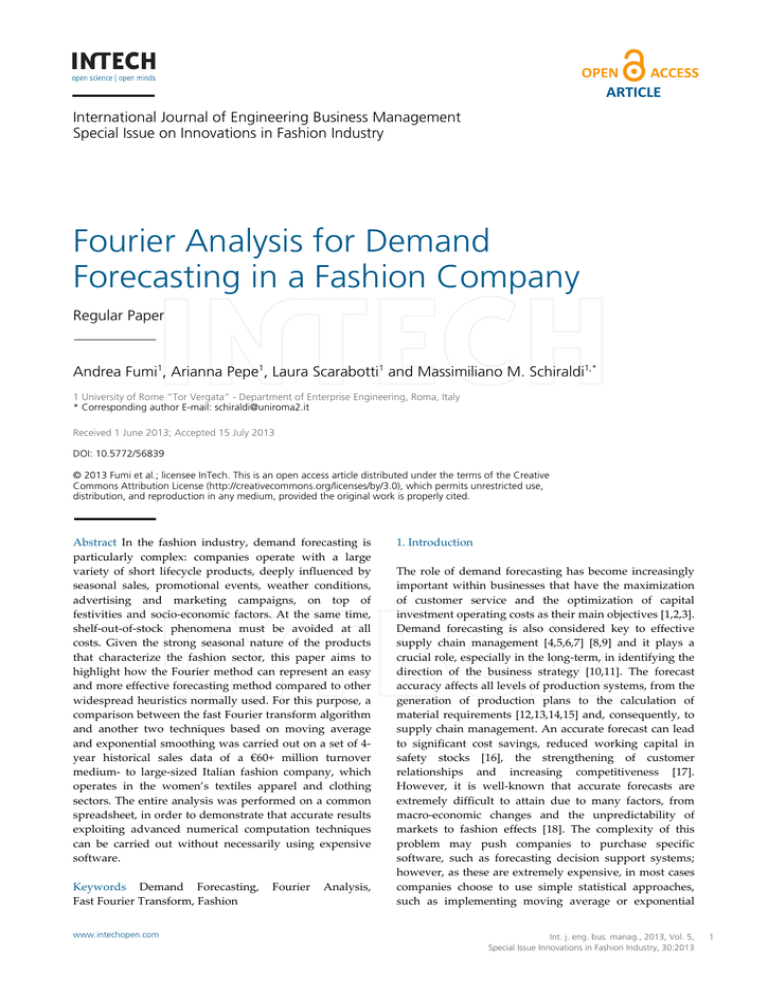
ARTICLE
International Journal of Engineering Business Management
Special Issue on Innovations in Fashion Industry
Fourier Analysis for Demand
Forecasting in a Fashion Company
Regular Paper
Andrea Fumi1, Arianna Pepe1, Laura Scarabotti1 and Massimiliano M. Schiraldi1,*
1 University of Rome “Tor Vergata” - Department of Enterprise Engineering, Roma, Italy
* Corresponding author E-mail: schiraldi@uniroma2.it
Received 1 June 2013; Accepted 15 July 2013
DOI: 10.5772/56839
© 2013 Fumi et al.; licensee InTech. This is an open access article distributed under the terms of the Creative
Commons Attribution License (http://creativecommons.org/licenses/by/3.0), which permits unrestricted use,
distribution, and reproduction in any medium, provided the original work is properly cited.
Abstract In the fashion industry, demand forecasting is
particularly complex: companies operate with a large
variety of short lifecycle products, deeply influenced by
seasonal sales, promotional events, weather conditions,
advertising and marketing campaigns, on top of
festivities and socio-economic factors. At the same time,
shelf-out-of-stock phenomena must be avoided at all
costs. Given the strong seasonal nature of the products
that characterize the fashion sector, this paper aims to
highlight how the Fourier method can represent an easy
and more effective forecasting method compared to other
widespread heuristics normally used. For this purpose, a
comparison between the fast Fourier transform algorithm
and another two techniques based on moving average
and exponential smoothing was carried out on a set of 4year historical sales data of a €60+ million turnover
medium- to large-sized Italian fashion company, which
operates in the women’s textiles apparel and clothing
sectors. The entire analysis was performed on a common
spreadsheet, in order to demonstrate that accurate results
exploiting advanced numerical computation techniques
can be carried out without necessarily using expensive
software.
Keywords Demand Forecasting,
Fast Fourier Transform, Fashion
www.intechopen.com
Fourier
Analysis,
1. Introduction
The role of demand forecasting has become increasingly
important within businesses that have the maximization
of customer service and the optimization of capital
investment operating costs as their main objectives [1,2,3].
Demand forecasting is also considered key to effective
supply chain management [4,5,6,7] [8,9] and it plays a
crucial role, especially in the long-term, in identifying the
direction of the business strategy [10,11]. The forecast
accuracy affects all levels of production systems, from the
generation of production plans to the calculation of
material requirements [12,13,14,15] and, consequently, to
supply chain management. An accurate forecast can lead
to significant cost savings, reduced working capital in
safety stocks [16], the strengthening of customer
relationships and increasing competitiveness [17].
However, it is well-known that accurate forecasts are
extremely difficult to attain due to many factors, from
macro-economic changes and the unpredictability of
markets to fashion effects [18]. The complexity of this
problem may push companies to purchase specific
software, such as forecasting decision support systems;
however, as these are extremely expensive, in most cases
companies choose to use simple statistical approaches,
such as implementing moving average or exponential
Andrea Fumi, Arianna Pepe, Laura Scarabotti
andbus.
Massimiliano
M. Schiraldi:
Int. j. eng.
manag., 2013,
Vol. 5,
Fourier Analysis
Demand
Forecasting
in a Fashion
Specialfor
Issue
Innovations
in Fashion
Industry,Company
30:2013
1
smoothing heuristics [19] on a common spreadsheet. As a
consequence, these basic forecasts need to be reviewed in
order to take into account exceptional circumstances or
events that may not emerge from historical data: as a
result, up to 80% of forecasts are adjusted [4], although
experimental evidence from some authors suggests that
judgmental adjustments to statistical forecasts are usually
unnecessary [20]. In the fashion industry, demand
forecasting is particularly complex [21,22,23,24]:
companies in this specific sector operate with a large
variety of short lifecycle products, deeply influenced by
seasonal sales [25,26,27], promotional events [28,29],
weather conditions, and advertising and marketing
campaigns [30], as well as festivities and economic and
social factors. Moreover, these slow-moving expensive
products usually face an intermittent or lumpy demand
[31], but at the same time – as they are usually high-margin
items - shelf-out-of-stock phenomena must be avoided at
all costs [32,33,8]. Thus, quick and effective supply chain
management, with flexible production schedules and
appropriate inventory levels, becomes critical for each
stock-keeping unit. For this reason, the demand forecasting
process needs to be timely and accurate.
Thanks to its capability in terms of decomposing a function
into a sum of sinusoids of different frequencies, amplitude
and phase, Fourier analysis can be used effectively for
seasonal sales forecasting; this is because the Fourier
transform takes a time series and maps it into a frequency
spectrum in the frequency domain. The discrete version of
the Fourier transform can be quickly calculated using fast
Fourier transform (FFT) algorithms. Given the strong
seasonal nature of the products that characterize the
fashion sector and the simplicity of computing FFT on
popular spreadsheets, such as Microsoft Excel, this paper
aims to highlight how the Fourier method can represent an
easy and more effective forecasting method compared to
other widespread alternatives normally used. For this
purpose, a comparison between FFT and two other
techniques based on moving average and exponential
smoothing was carried out on a set of 4-year historical sales
data of a €60+ million turnover medium- to large-sized
Italian fashion company operating in women’s textiles
apparel and clothing sectors which distributes over 2,500
products to more than 200 shops.
2. Previous Research
Forecasting approaches can be divided into qualitative
and quantitative methods [34]. Here, we focus on
quantitative methods based on the study of historical
time series [35]. Among these, the most well-known are
the moving average and the exponential smoothing
methods - Holt-Winters’ method [36] and regressive
methods [37]. However, in having to deal with lumpy
demand, Croston’s method [38] [39] and its evolution as
offered by Syntetos and Boylan [40] represent a better
2
Int. j. eng. bus. manag., 2013, Vol. 5,
Special Issue Innovations in Fashion Industry, 30:2013
alternative. Other methods that have been used in the
fashion industry - providing successful results in sales
prediction - include two-stage dynamic sales forecasting
models [41], fuzzy logic approaches [42], artificial neural
networks [43] and extreme learning machines [44,8,45].
Despite their effectiveness, few commercial software
solutions implement these methods for forecasting. The
few that do are often too expensive for small- or mediumsized companies. As a result, in practical cases, most
companies use basic heuristics implemented on common
spreadsheets. However, common spreadsheets do not
support only basic techniques: for instance, the Fast Fourier
Transform - which has been widely used and applied in
many fields ranging from physics, seismology, engineering
and economics and has been described as the “most
important numerical algorithm of our lifetime” [46] – is
easily available in Microsoft Excel. The use of Fourier
analysis in forecasting overcomes certain limitations that
other techniques have in capturing seasonality phenomena
[47]. Therefore, this approach has been used for forecasting
changes in electricity demand and/or prices [48,49], which
are variables that are clearly related to light and
temperature cyclic variations. In forecasting consumers’
behaviour, it has been used for estimating the volumes of
incoming calls in a call centre [50] and has been integrated
with a linear equation for forecasting motorcycle sales with
successful results [51], whilst it did not lead to significant
improvements for forecasting automobile sales [52]. Apart
from these few examples, FFT seems to be applied only
rarely for forecasting consumer goods sales and – to the
authors’ knowledge – no contributions seem to be present
in the literature for forecasting consumer goods sales,
specifically in the fashion industry. The fashion industry is
progressively drawing the attention of researchers due to
its increasing importance in the worldwide economy and
the peculiarities of its operations’ practices. For example,
recent studies focused on fashion firms in analysing brand
value [53], organizational innovation [54,55,56], production
efficiency increase [57,58] and improvements in logistics
processes [59,24,60]. For an updated and complete review
of the forecasting techniques in the fashion industry, refer
to Nenni et al. [61].
The next section presents in detail both the methodology
and the step-by-step procedure used to apply FFT on
historical time series to predict sales. Next, the results of
the validation of the proposed approach on the real data
of a fashion company are presented.
3. Methodology
This section presents both the methodology and the stepby-step procedure used to apply FFT to historical time
series to forecast sales in detail. In the next section, results
proving the effectiveness of the suggested approach are
shown by analysing a fashion company’s data. The whole
analysis was performed on a common spreadsheet in
www.intechopen.com
order to prove that accurate analyses exploiting advanced
numerical computation techniques can be carried out
without needing to use expensive software. Microsoft
Excel software is able to compute FFT on a data vector.
The FFT algorithm significantly reduces computational
times compared to the standard Fourier transform [62],
and specifically from O(n2) to O(n⋅log(n)) [63]. Although
Microsoft Excel is not primarily conceived to perform
such mathematical analyses, it is easy and quick to
calculate the discrete Fourier transform (DFT) and its
inverse function on a data range. The tool’s only
constraint is that the number of input values must be a
power of 2, up to the value of 4,096; however, this should
not represent a limitation for these types of analyses
(4,096 values can describe a sales record over more than
eleven years with daily samples, or over more than 78
years with weekly samples).
In this analysis, the FFT was used to perform spectral
analysis on sales patterns in order to attain a frequency
spectrum (the representation of which is often referred to
as a “periodogram”). This is because the Fourier transform
can decompose a periodic series into a sum of sinusoidal
functions (harmonic components [64], specifically cosine
functions in Microsoft Excel [65]). The FFT returns complex
numbers from which it is possible to extract information –
frequency (f), amplitude (A), and phase (ϕ) – of N/2
periodic waves that form the sales pattern, where N is the
total number of time periods of sales data, which is also the
size of the sample (for the limit of N/2 sine waves see
Nyquist –Shannon sampling criterion in signal theory [66]).
Thus, the result of the Fourier transform is:
���� � ∑������� ��� ���� � � �� ��� ���� ��
imaginary part. Excel provides simple functions that can
be easily used to calculate the amplitude and phase of
each of the N/2 significant components, from each
complex number Ai:
|�� | = IMABS (Ai) / (N/2)
ϕi
= IMARGUMENT (Ai)
(1)
(2)
It is worth noting that the amplitude of the first
component (the average value of the series,
corresponding to the f0 frequency) is obtained by
calculating the absolute value of the first complex number
of the array but dividing it by N and not by N/2, since
there is no conjugated value associated to it. The most
significant components are those with the highest
amplitude. The sales forecast pattern can therefore be
attained by summing a specific number of components
(i.e., with the inverse Fourier transform) chosen among
the most significant of them. A critical issue is how to
select the correct number of components to consider; this
is explained in detail in the case study paragraph. Figure
1 shows some periodogram examples resulting from the
spectrum analysis of different signals.
(1)
However, the following simplification can be considered
[67]:
���� � ∑���� �� �������� � � �� �
(2)
Where k = N/2.
Applying the Microsoft Excel Fourier analysis tool on a Nsized data range, it yields an N-sized range of complex
numbers which contain information on N components.
However, as previously stated, only the first half should be
considered. This is because the second half of the series
shows the conjugated values, symmetrical with respect to
the Nyquist-Shannon frequency, which is fc/2 where fc is the
sampling frequency. The spectral resolution is:
�� �
��
�
The amplitudes of the i-th component can be calculated
as the absolute value of the i-th complex number
�� � �� � ��� , where a is the real part and b is the
www.intechopen.com
Figure 1. Examples of periodograms generated from different
signals.
The procedure to be applied to a historical time series is
summarized below. Clearly, before performing the
analysis, the items/products to be analysed and the level
of detail of the analysis must be chosen. Specifically,
when dealing with fashion products (and specifically
with the more expensive women’s clothing, purses or
accessories) it is often impossible to drill down the
analysis to manage the volume of sales per product / per
day / per shop due to the fact that, at such level of detail,
the average values can be close to zero or statistically
insignificant. Thus, data is usually analysed using weekly
Andrea Fumi, Arianna Pepe, Laura Scarabotti and Massimiliano M. Schiraldi:
Fourier Analysis for Demand Forecasting in a Fashion Company
3
time buckets. On top of this, product sales are often
grouped by category or sub-category and/or shops are
grouped by market region. Thus, forecasts are first
calculated at an aggregated level and then the volumes
are brought back to the most appropriate level of detail
through heuristic ratios. Hence, after having chosen the
most appropriate time bucket and product aggregation, a
10-step procedure to attain an accurate forecast through
Fourier analysis is employed, as follows:
1. Extract the historical series of data related to the
item to be analysed over a significant time interval
(e.g., 4 years);
2. Divide the data into two subsets: a calibration data
set (e.g., the first 3 years) and a validation data set
(e.g., the 4th year), which allows the quality of the
results to be analysed; the calibration set should be
composed of N values (e.g., in Excel, N needs to be a
power of two);
3. Calculate a linear trend of the series of the
calibration set and subtract it from the data series
[68] (e.g., in Excel, the TREND function may help);
4. Calculate the FFT on the detrended data (e.g., in
Excel, the Fourier analysis tool gives a range of
complex numbers);
5. Create the frequency spectrum by calculating, for
each of the first N/2 components, their amplitude
and phase (e.g., in Excel, using (1) and (2) in the
complex numbers’ range);
6. Except for f0, order the f1… fN/2 components in a
decreasing order of amplitude;
7. Perform the inverse Fourier transform N/2 times (or
sum the wave components), taking into account
each of the N/2 components progressively, starting
from f0 up to the N/2-th;
8. Re-apply the eliminated trend, calculated in step 3,
to each of the N/2 inverse Fourier transforms;
9. Compare the validation data set with each of the
N/2 inverse Fourier transforms, calculating the
forecast error with the preferred method [69] (e.g.,
mean absolute percentage error, MAPE).
10. Choose the most appropriate number of wave
components to consider in order to minimize the error.
Note that this 10-step procedure needs to be performed
only the first time a given item k (product, category,
subcategory, etc.) is analysed. This is because, once the
most appropriate number of wave components to be
applied has been chosen (say, θk), to further improve the
forecast, steps 6, 7, 8, 9 and 10 can be substituted with the
following:
6. Perform the inverse Fourier transform, taking into
account f0 and the first θk components with
decreasing amplitude;
7. Re-apply the eliminated trend, calculated in step 3,
to the inverse Fourier transform calculated in the
previous step 6.
4
Int. j. eng. bus. manag., 2013, Vol. 5,
Special Issue Innovations in Fashion Industry, 30:2013
Clearly, θk may easily differ from item to item. Despite
choosing a unique θ = θk ∀k, it may provide acceptable
results through an easier and more straightforward
procedure, and a first tuning analysis is advisable,
particularly when product categories drastically differ
(e.g., purses, scarves and coats all belong to the general
“women fashion products” category but may show very
different sales patterns over the same time period). In the
following section, the application of the procedure is
shown with two examples of the use of Fourier analysis
to forecast the sales in the trolley category and the belt
category.
4. Application to fashion products
This section presents the application of Fourier analysis to
calculate the sales forecasts for a medium- to large-sized
Italian fashion company operating in the women’s
textiles, apparel and clothing sectors. Several product
categories were analysed and, as a result, the application
of the proposed method generally yielded more accurate
forecasts in comparison with two of the most commonlyused approaches based on moving average and
exponential smoothing. Two examples are presented
here: the trolley sub-category and the belt sub-category.
The Fourier analysis applied to the historical series of the
former returned a much more precise forecast, while with
the latter the forecasting error was comparable with that
obtained with the other two approaches. In all cases, the
historical series included the calibration data set (sales
during 2007, 2008 and 2009) and the validation data set
(sales during 2010). With the moving average and
exponential smoothing techniques, the traditional
approaches [70] were used to calculate weekly ratios
using three periods of historical data (2007, 2008 and
2009). The forecast (α) parameter in the exponential
smoothing was chosen in a different way in each case, by
using the one that returned the best results. In the Fourier
analysis, since the input range must be a power of two,
the calibration set was reduced to the period from
19/07/2007 to 31/12/2009 - i.e., N = 128 weeks - while the
validation set was kept the same (from 01/01/2010 to
31/12/2010). As the sampling frequency is equal to fc = 1
ଵ
week, the spectral resolution is equal to ο݂ ൌ ଵଶ଼. Despite
that the Fourier analysis operated within a smaller
historical data range, the forecast turned out to be more
accurate, as may be seen in the following cases.
4.1 The trolley sub-category
The calibration data set of the trolley sub-category sales is
shown in Figure 2.
Starting from f0, the other components in the spectrum
were sorted by decreasing amplitude, according to step 6
in the mentioned procedure. The result is shown in
Figure 4.
www.intechopen.com
Trolley sub-category sales
Component
Amplitude
Frequency
Phase
f0
f5
f3
63.8
67.7
40.5
0.04
0.02
-1.04
-0.73
f4
40.0
0.03
+2.72
f8
33.9
0.06
-1.77
f1
30.5
0.01
+2.31
f10
27.2
0.08
-2.47
1000
800
600
400
200
Table 1. Amplitude, frequency and phase of the chosen components.
127
120
113
99
106
92
85
Weeks
78
71
64
57
50
43
36
29
22
8
15
1
0
Figure 2. Calibration data set of the trolley sub-category sales (in
units).
The FFT yielded the frequency spectrum shown in Figure 3.
Trolley sub-category sales spectrum
80
y(t) = 63.8 + 67,7 ⋅ cos(2π ⋅ 0.04 ⋅ t – 1.04) +
+ 40.5 ⋅ cos(2π ⋅ 0.02 ⋅ t – 0.73) +
+ 40.0 ⋅ cos(2π ⋅ 0.03 ⋅ t + 2.72) +
+ 33.9 ⋅ cos(2π ⋅ 0.06 ⋅ t – 1.77) +
+ 30.5 ⋅ cos(2π ⋅ 0.01 ⋅ t + 2.31) +
+ 27.2 ⋅ cos(2π ⋅ 0.08 ⋅ t – 2.47)
MAPE for N/2 different forecasts
140%
120%
70
100%
60
50
80%
40
60%
30
40%
20
20%
10
0%
1 4 7 10 13 16 19 22 25 28 31 34 37 40 43 46 49 52 55 58 61 64
Number of considered components
Fo
0.01
0.02
0.02
0.03
0.04
0.05
0.05
0.06
0.07
0.08
0.09
0.09
0.10
0.11
0.12
0.13
0.13
0.14
0.15
0.16
0.16
0.17
0.18
0.19
0.20
0.20
0.21
0.22
0.23
0.23
0.24
0.25
0.26
0.27
0.27
0.28
0.29
0.30
0.30
0.31
0.32
0.33
0.34
0.34
0.35
0.36
0.37
0.38
0.38
0.39
0.40
0.41
0.41
0.42
0.43
0.44
0.45
0.45
0.46
0.47
0.48
0.48
0.49
0
Frequencies
Components ordered by decreasing amplitude
80
70
60
50
40
30
20
10
Fo
0.04
0.02
0.03
0.06
0.01
0.08
0.13
0.17
0.16
0.20
0.10
0.07
0.09
0.34
0.16
0.48
0.32
0.38
0.13
0.23
0.19
0.35
0.05
0.38
0.28
0.41
0.24
0.49
0.20
0.14
0.48
0.30
0.45
0.31
0.05
0.39
0.27
0.45
0.29
0.33
0.22
0.36
0.02
0.21
0.18
0.27
0.23
0.42
0.26
0.34
0.37
0.41
0.25
0.30
0.12
0.44
0.46
0.09
0.15
0.11
0.43
0.47
0.40
0.5
0
Frequencies
Figure 4. Components ordered by decreasing amplitude
(the first is f0).
Then, N/2 inverse Fourier transforms can be calculated
using different numbers of components, as mentioned in
step 7 of the procedure described. Next, the trend is
applied to each of them and the results are compared
with the validation set. Figure 5 shows the MAPE index
for each of the N/2 possible forecasts: the smallest error is
recorded using 6 components, thus θtrolley = 6.
The following Table 1 shows the characteristics of the 6
chosen components – starting from f0 – followed by the
mathematical expression of the forecast function y(t).
www.intechopen.com
Figure 5. MAPE for all of the 64 possible forecasts.
Figure 6 shows the comparison between the forecasts
obtained using Fourier analysis, exponential smoothing and
moving average. Obviously, the Fourier forecast succeeded in
following the validation data pattern more effectively, while
exponential smoothing and moving average techniques
yielded more or less the same results. Specifically, it is clear
that the huge peak that both the exponential smoothing and
moving average techniques forecast for weeks 162-165
results from a similar peak in weeks 85-88 of the calibration
data set shown in Figure 2. This is because neither of these
classical techniques can ignore the high values recorded in
the same period of the previous season; on the contrary, the
Fourier analysis forecast tends to confirm only those
increments that are recorded cyclically.
These results are confirmed by the numerical comparison
shown in Table 2, where the Fourier analysis is shown to
yield a much smaller error, both in terms of MAPE and
MAD (the exponential smoothing α parameter was set to
its best value, α = 0.96).
Forecasting technique
Trolley
Figure 3. Frequency spectrum computed on the calibration data set.
Moving average
Exponential smoothing
Fourier analysis
MAD
MAPE
38.0
39.7
27.0
104.0%
108.4%
74.0%
Table 2. Comparison of forecast errors.
Andrea Fumi, Arianna Pepe, Laura Scarabotti and Massimiliano M. Schiraldi:
Fourier Analysis for Demand Forecasting in a Fashion Company
5
Forecasting results comparison
400
350
units
300
Fourier
Validation data set
Mov average
Exp smoothing
Components ordered by decreasing amplitude
1200
1000
800
250
200
600
150
400
100
200
50
0
0
Fo
0.04
0.08
0.13
0.06
0.09
0.09
0.15
0.30
0.10
0.13
0.03
0.02
0.18
0.19
0.34
0.22
0.26
0.14
0.40
0.07
0.27
0.44
0.12
0.38
0.05
0.48
0.23
0.17
0.11
0.16
0.36
0.05
0.30
0.34
0.48
0.20
0.47
0.37
0.02
0.21
0.41
0.33
0.46
0.41
0.45
0.32
0.25
0.38
0.45
0.42
0.24
0.16
0.31
0.29
0.43
0.28
0.49
0.01
0.27
0.35
0.39
0.20
0.23
129 132 135 138 141 144 147 150 153 156 159 162 165 168 171 174 177 180
Weeks
Figure 6. Forecasting results comparison.
4.2 The belt sub-category
The calibration data set of the belt sub-category sales is
shown in Figure 7.
Belt sub-category sales
Frequencies
Figure 9. Components ordered by decreasing amplitude
(the first is f0).
MAPE for N/2 different forecasts
140%
120%
100%
10000
80%
8000
60%
40%
6000
20%
4000
0%
1 4 7 10 13 16 19 22 25 28 31 34 37 40 43 46 49 52 55 58 61 64
Number of considered components
2000
0
1
8
15
22
29
36
43
50
57
64
71
78
85
92
99
106
113
120
127
Figure 10. MAPE index for all 64 possible frequencies.
Weeks
Figure 7. calibration data set of belt sub-category sales (in units)
The Fast Fourier Transform yielded the frequency
spectrum shown in Figure 9.
Belt sub-category sales spectrum
1200
1000
800
600
400
200
Fo
0.01
0.02
0.02
0.03
0.04
0.05
0.05
0.06
0.07
0.08
0.09
0.09
0.10
0.11
0.12
0.13
0.13
0.14
0.15
0.16
0.16
0.17
0.18
0.19
0.20
0.20
0.21
0.22
0.23
0.23
0.24
0.25
0.26
0.27
0.27
0.28
0.29
0.30
0.30
0.31
0.32
0.33
0.34
0.34
0.35
0.36
0.37
0.38
0.38
0.39
0.40
0.41
0.41
0.42
0.43
0.44
0.45
0.45
0.46
0.47
0.48
0.48
0.49
0
It is clear that, in this example, the forecasts gave more
accurate results compared to the trolley case depicted in
Figure 5: the smallest error is recorded using 17
components, thus θbelt = 17. Figure 11 shows the
comparison between the forecasts attained through
Fourier analysis, exponential smoothing and moving
average. In this case, despite the fact that the Fourier
analysis followed the validation data set more accurately,
the difference between the suggested method and the
results attained with the moving average and the
exponential smoothing techniques is not as clear as in the
trolley case. In terms of MAD and MAPE, the numerical
values are shown in Table 3 (the exponential smoothing α
parameter was set to its best value, α = 0.98).
Frequencies
Figure 8. frequency spectrum calculated on calibration data set
Starting from f0, the other components in the spectrum
were sorted by decreasing amplitude, according to step 6
in the mentioned procedure. The results are shown in
Figure 9.
The results for all 64 possible frequencies, expressed by
the index MAPE, are represented in Figure 10.
6
Int. j. eng. bus. manag., 2013, Vol. 5,
Special Issue Innovations in Fashion Industry, 30:2013
The differences between the results obtained in the trolley
and belt cases originate from the specific patterns of their
historical time series. As may be seen comparing Figure 2
with Figure 7, the belt sub-category historical sales show
a much clearer cyclic pattern, with periodic peaks
repeating over time and gradually decreasing in value. In
the belt sub-category, both the moving average and the
exponential smoothing methods were able to capture the
pattern’s cyclicality, despite the decreasing trend in the
peak values not being perfectly forecast, as would be
expected when using these original techniques [19]. On
the other hand, the trolley sub-category historical sales
pattern was more irregular, with a sudden high peak of
www.intechopen.com
sales in the last season. This recent high peak significantly
influenced the moving average and exponential
smoothing techniques, and both methods forecasted a
higher sales volume compared to what really occurred.
On the contrary, in both cases the Fourier analysis
yielded much more accurate results.
Forecasting results comparison
Validation data set
Fourier
Mov average
Exp smoothing
7000
6000
5000
units
4000
3000
2000
1000
0
129 132 135 138 141 144 147 150 153 156 159 162 165 168 171 174 177 180
Weeks
Belt
Figure 11. Comparison of the forecast results.
Forecasting technique
MAD
MAPE
Moving average
Exponential smoothing
Fourier analysis
532.0
533.1
414.0
55.1%
55.2%
43.0%
Table 3. Comparison of forecast errors.
5. Conclusion
Accurate forecasts are extremely difficult to attain. As a
result, large-sized companies may be pushed to purchase
expensive forecasting software, whilst small- and
medium-sized enterprises generally choose to use simple
statistical approaches on common spreadsheets.
However, common spreadsheets do not support only
basic techniques: for instance, the fast Fourier transform
(FFT) - which has been widely used and applied in many
fields ranging from physics, seismology, engineering and
economics - allows certain limitations present in other
techniques in capturing seasonality phenomena to be
overcome. Therefore, thanks to its capability in terms of
decomposing a function into a sum of sinusoids of
different frequencies, amplitude and phase, Fourier
analysis has been used for forecasting changes in
electricity demand and/or prices. However, it seems to be
only rarely applied in consumer goods sales forecasting,
and no contributions seem to be present in the literature
for forecasting consumer goods sales, specifically in the
fashion industry. In this paper, a comparison between the
FFT analysis in Microsoft Excel and another two
techniques based on moving average and exponential
smoothing methods was carried out on a set of 4-year
historical sales data (3-years calibration data set, 1-year
validation data set) of a €60+ million turnover medium- to
large-sized Italian fashion company operating in the
women’s textiles, apparel and clothing sectors, and which
www.intechopen.com
distributes over 2,500 products to more than 200 shops.
The results show how Fourier analysis represents a valid
alternative forecasting technique among those that can be
easily implemented on a common spreadsheet. Clearly,
its effectiveness varies with the sales pattern
characteristics: for certain sets of historical data, the
suggested approach can attain much more accurate
results compared to other simple heuristics, such as
moving average or exponential smoothing methods. In
other patterns, the accuracy can be comparable. In this
paper, the weekly sales of two product categories were
analysed: for both categories, Fourier analysis yielded a
smaller error both in terms of MAPE and MAD compared
to the other two classical techniques; however, for one
category, which displayed quite an irregular historical
pattern, Fourier analysis reduced the error by 30% on
average between the two indexes; on the contrary, for the
second category, which displayed a more regular
historical pattern, the average error reduction was 22%. A
10-step simple and straightforward procedure is described
and no complex data processing procedure is required.
Clearly, further improvements can originate from the
application of those techniques that were conceived of in
signal theory to refine the Fourier transform (e.g.,
reducing spectrum leakage through an appropriate signal
windowing procedure). However, in this study the
approach was intentionally described in its simplest form,
in order to provide a solid foundation both for
researchers and practitioners.
7. References
[1] Rexhausena D, Pibernik R, Kaiser G. (2012)
Customer-facing supply chain practices—The impact
of demand and distribution management on supply
chain success. Journal of Operations Management.
30(4): 269-281.
[2] Syntetos AA, Nikolopoulos K, Boylan JE. (2010)
Judging the judges through accuracy-implication
metrics: The case of inventory forecasting.
International Journal of Forecasting. 26(1): 134–143.
[3] Graves SK. (1998) A dynamic model for requirements
planning with application to supply chain
optimization. Operations Research. 46(3): 35-49.
[4] Fildes R, Goodwin P, Lawrence M, Nikolopoulos K.
(2009) Effective forecasting and judgmental
adjustments: an empirical evaluation and strategies
for improvement in supply-chain planning.
International Journal of Forecasting. 25(1): 3-23.
[5] Acara Y, Gardner ES. (2012) Forecasting method
selection in a global supply chain. International
Journal of Forecasting. 28(4): 842-848.
[6] Turrado García F, García Villalba LJ, Portela J. (2012)
Intelligent system for time series classication using
support vector machines applied to supply chain.
Expert Systems with Applications. 39(12): 1059010599.
Andrea Fumi, Arianna Pepe, Laura Scarabotti and Massimiliano M. Schiraldi:
Fourier Analysis for Demand Forecasting in a Fashion Company
7
[7] Fisher ML, Hammond JH, Obermeyer WR, Ramen A.
(1994) Making Supply Meet Demand in an Uncertain
World. Harvard Business Review. May-June 1994:
83-93.
[8] Xia M, Zhang Y, L. W, Ye X. (2012) Fashion retailing
forecasting based on extreme learning machine with
adaptive metrics of inputs. Knowledge-Based
Systems. 36: 253–259.
[9] Guo ZX, Wong WK, Li M. (2013) A multivariate
intelligent decision-making model for retail sales
forecasting. Decision Support Systems. 55(1): 217-255.
[10] Smith CD, Mentzer JT. (2010) Forecasting tasktechnology t: The inuence of individuals,systems
and
procedures
on
forecast
performance.
International Journal of Forecasting. 26(1): 144–161.
[11] Haq AN, Kannan G. (2006) Effect of forecasting on
the multi-echelon distribution inventory supply
chain cost using neural networks, genetic algorithm
and particle swarm optimization. Internation Journal
of Services Operations. 1(1/2): 1-22.
[12] Bregni A, D’Avino M, De Simone V, Schiraldi MM.
(2013) Formulas of Revised MRP. International
Journal of Engineering Business Management. 5(10):
1-10.
[13] D’Avino M, De Simone V, Schiraldi MM. (2013)
Revised MRP for reducing inventory level and
smoothing order releases: a case in manufacturing
industry. Production Planning & Control. in press DOI:10.1080/09537287.2013.764579.
[14] D’Avino M, Bregni A, Schiraldi MM. (2013) A
revised and improved version of the MRP algorithm:
Rev MRP. Applied Mechanics and Materials. 328:
276-280.
[15] D'Avino M, Macry Correale M, Schiraldi MM. (2013)
No news, good news: positive impacts of delayed
information in MRP. International Journal of
Management and Decision Making. 12 (3), in press.
[16] Nenni ME, Schiraldi MM. (2013) Validating Virtual
Safety Stock Effectiveness through Simulation.
International Journal of Engineering Business
Management. in press.
[17] Moon MA, Mentzer JT, Smith CD. (2003) Conducting
a sales forecasting audit. International Journal of
Forecasting. 19(1): 19-25.
[18] Fildes R, Beard C. (1992) Forecasting systems for
production and inventory control. International
Journal of Production and Operations Management.
12(5): 4-27.
[19] Holt CC. (2004) Forecasting seasonals and trends by
exponentially
weighted
moving
averages.
International Journal of Forecasting. 20(1): 5-10.
[20] Lawrence M, Goodwin P, O’Connor M, Onkal D.
(2006) Judgmental forecasting: A review of progress
over the last 25 years. International Journal of
Forecasting. 22(3): 493-518.
8
Int. j. eng. bus. manag., 2013, Vol. 5,
Special Issue Innovations in Fashion Industry, 30:2013
[21] Yu Y, Hui CL, Choi TM. (2012) An empirical study of
intelligent expert systems on forecasting of fashion
color trend. Expert Systems with Applications. 39(4):
4383–4389.
[22] Au KF, Choi TM, Yu Y. (2008) Fashion retail
forecasting by evolutionary neural networks.
International Journal of Production Economics.
114(2): 615-630.
[23] Hammond JH. (1991) Quick response in the apparel
Industries. Harvard Business School Background
Note 690-038, April 1991..
[24] Battista C, Schiraldi MM. (2013) The Logistic
Maturity Model: application to a fashion firm.
International Journal of Engineering Business
Management. in press.
[25] Mostard J, Teunter R, de Koster R. (2011) Forecasting
demand for single-period products: A case study in
the apparel industry. European Journal of
Operational Research. 211(1): 139–147.
[26] Wong WK, Guo V. (2010) A hybrid intelligent model
for medium-term sales forecasting in fashion retail
supply chains using extreme learning machine and
harmony search algorithm. International Journal of
Production Economics. 128(2): 614–624.
[27] Sen A. (2008) The US fashion industry: A supply
chain review. International Journal of Production
Economics. 114(2): 571–593.
[28] Thomassey S. (2010) Sales forecasts in clothing
industry: The key success factor of the supply chain
management. International Journal of Production
Economics. 128(2): 470-483.
[29] Chen FL, Ou TY. (2011) Sales forecasting system
based on Gray extreme learning machine with
Taguchi method in retail industry. Expert Systems
with Applications. 38(3): 1336–1345.
[30] De Toni A. (2000) The production planning process
for a network of firms in the textile–apparel industry.
International Journal of Production Economics. 65(1):
17-32.
[31] Chatfield DC, Hayya JC. (2007) All-zero forecasts for
lumpy demand: a factorial study. International
Journal of Production Research. 45(4): 935–950.
[32] Sanuwar R (2013) The Role of Quick Response for
Demand Driven Globalized Apparel Supply Chain
Management London: Springer.
[33] Martin C, Lowson R, Peck H. (2004) Creating agile
supply chains in the fashion industry. International
Journal of Retail and Distribution Management.
32(8): 367-376.
[34] Caniato F, Kalchschmidt M, Ronchi S. (2011)
Integrating quantitative and qualitative forecasting
approaches: organizational learning in an action
research case. Journal of the Operational Research
Society. 62: 413–424.
[35] Abraham B, J Ledolter J (2009) Statistical Methods for
Forecasting New Jersey: Wiley Interscience.
www.intechopen.com
[36] Winters P. (1960) Forecasting sales by exponentially
weighted moving averages. Management Science.
6(3): 324-342.
[37] Mills TC (2013) A Very British Affair: Six Britons and
the Development of Time Series Analysis During the
20th Century UK: Palgrave McMillan.
[38] Croston J. (1972) Forecasting and stock control for
intermittend
demands.
Operational
Research
Quarterly. 23(3): 289-304.
[39] Paliwal M, Usha A. Kumar UA. (2009) Neural
networks and statistical techniques: A review of
applications. Expert Systems with Applications.
39(1): 2-17.
[40] Syntetos AB. (2005) The accuracy of intermittent
demand
estimates.
Internationl
Journal
of
Forecasting. 21(2): 303-314.
[41] Ni Y, Fan F. (2011) A two-stage dynamic sales
forecasting model for the fashion retail. Expert
Systems with Applications. 38(3): 1529-1536.
[42] Thommassey S. (2005) A global forecasting support
system adapted to textile distribution. International
Journal of Production Economics. 96(1): 81-95.
[43] Gutierrez RS, Solis AO, Bendore NR. (2004) Lumpy
demand
characterization
and
forecasting
performance: an exploratory case study. In
Proceedings of the WDIS 2004 Conference
[44] Tsan-Ming C. (2012) Supply Chain Management in
Textiles and Apparel. Journal Textile Science &
Engineering. 2(2): 1-2.
[45] Yu Y, Choi TM, Hui CL. (2011) An intelligent fast
sales forecasting model for fashion products. Expert
Systems with Applications. 38(6): 7373–7379.
[46] Strang G. (1994) Wavelets. American Scientist. 82(3):
250-255.
[47] Lye KW, Yuan M, Cai TX. (2009) A spectrum
comparison method for demand forecasting.
SIMTech technical reports. 10(1): 32-35.
[48] McLoughlin F, Duffy A, Conlonb M. (2013)
Evaluation of time series techniques to characterise
domestic electricity demand. Energy. 50(1): 120-130.
[49] Pedregal DJ, Trapero JR. (2007) Electricity prices
forecasting by automatic dynamic harmonic
regression models. Energy Conversion and
Management. 48(5): 1710-1719.
[50] Lewis BG, Herbert RD, Bell RD. (2003) The
Application of Fourier Analysis to Forecasting the
Inbound Call Time Series of a Call Centre. In
Proceedings of the International Congress on
Modeling and Simulation MODSIM03); Townsville,
Australia p. 1281-1286.
[51] Oladebeye DH, Ejiko OS. (2012) Developmento of
Fourier series forecasting model for predicting
selected company sales volume. Science Engineering
Environmental
Management
Research
&
Development Journal. 1(1): 42-54.
www.intechopen.com
[52] Hülsmann M, Borsheid D, Friedrich CM, Reith D.
(2012) General Sales Forecast Model for Automobile
Markets and their Analysis. Transactions on Machine
learning and Data Mining. 5(2): 65-86.
[53] Battistoni E, Fronzetti Colladon A, Mercorelli G.
(2013) Prominent determinants of consumer based
brand equity. International Journal of Engineering
Business Management. in press.
[54] De Felice F, Petrillo A, Autorino C. (2013) Key
success factors for organizational innovation in the
fashion
industry.
International
Journal
of
Engineering Business Management. in press.
[55] Pirolo L, Giustiniano L, Nenni ME. (2013) The Italian
footwear
industry:
an
empirical
analysis.
International Journal of Engineering Business
Management. in press.
[56] D'Amico S, Giustiniano L, Nenni ME, Pirolo L. (2013)
Product Lifecycle Management as a tool to create
value in the fashion system. International Journal of
Engineering Business Management. in press.
[57] De Carlo F, Borgia O, Tucci M. (2013) Bucket
brigades to increase productivity in a luxury
assembly line. International Journal of Engineering
Business Management. in press.
[58] De Carlo F, Arleo MA, Borgia O, Tucci M. (2013)
Layout design for a low capacity manufacturing line:
a case study. International Journal of Engineering
Business Management. in press.
[59] Iannone R, Ingenito A, Martino G, Miranda S, Pepe
C, Riemma S. (2013) Merchandise and replenishment
planning
optimization
for
fashion
retail.
International Journal of Engineering Business
Management. in press.
[60] Costantino F, Di Gravio G, Shaban A, Tronci M. (2013)
Exploring bullwhip effect and inventory stability in a
seasonal supply chain. International Journal of
Engineering Business Management. in press.
[61] Nenni ME, Giustiniano L, Pirolo L. (2013) Demand
forecasting in the fashion industry: a review.
International Journal of Engineering Business
Management. in press.
[62] Stremler F (1990) Introduction to Communications
Systems Third edition USA: Addison-Wesley.
[63] Gonzalez O. (1990) Pitfalls of signal analysis.
Mechanical Engineering. February 1990: 72-74.
[64] Marhavilas PK, Koulouriotis DE, Spartalis SH. (2013)
Harmonic analysis of occupational-accident time
series as a part of the quantified risk evaluation in
worksite: Application on electic power industry and
construction sector. Reliability Engineering and
System Safety. 112(April 2013): 8-25.
[65] Kerr DA. (2009) The Fourier Analysis Tool in
Microsoft Excel (working paper)..
[66] Proakis J, Manolakis D (1992) Digital Signal
Processing : Principles, Algorithms, and Applications
New York: Macmillan Publishing Company.
Andrea Fumi, Arianna Pepe, Laura Scarabotti and Massimiliano M. Schiraldi:
Fourier Analysis for Demand Forecasting in a Fashion Company
9
[67] Bartafai I. (2002) An illustration of harmonic
regression based on the results of the Fast Fourier
transformation. Yugoslav Journal of Operations
Research. 12(2): 185-201.
[68] Garcia-Ferrer A, Del Hoyo J. (1992) On trend
extraction models: Interpretation, empirical evidence
and forecasting performance. Journal of Forecasting.
11(8): 645-655.
10 Int. j. eng. bus. manag., 2013, Vol. 5,
Special Issue Innovations in Fashion Industry, 30:2013
[69] Armstrong JS, Collopy F. (1992) Error measures for
generalizing about forecasting methods: Empirical
comparisons. International Journal of Forecasting.
8(1): 69-80.
[70] Wei WWS (1994) Time Series Analysis Boston:
Pearson / Addison Wesley.
www.intechopen.com


